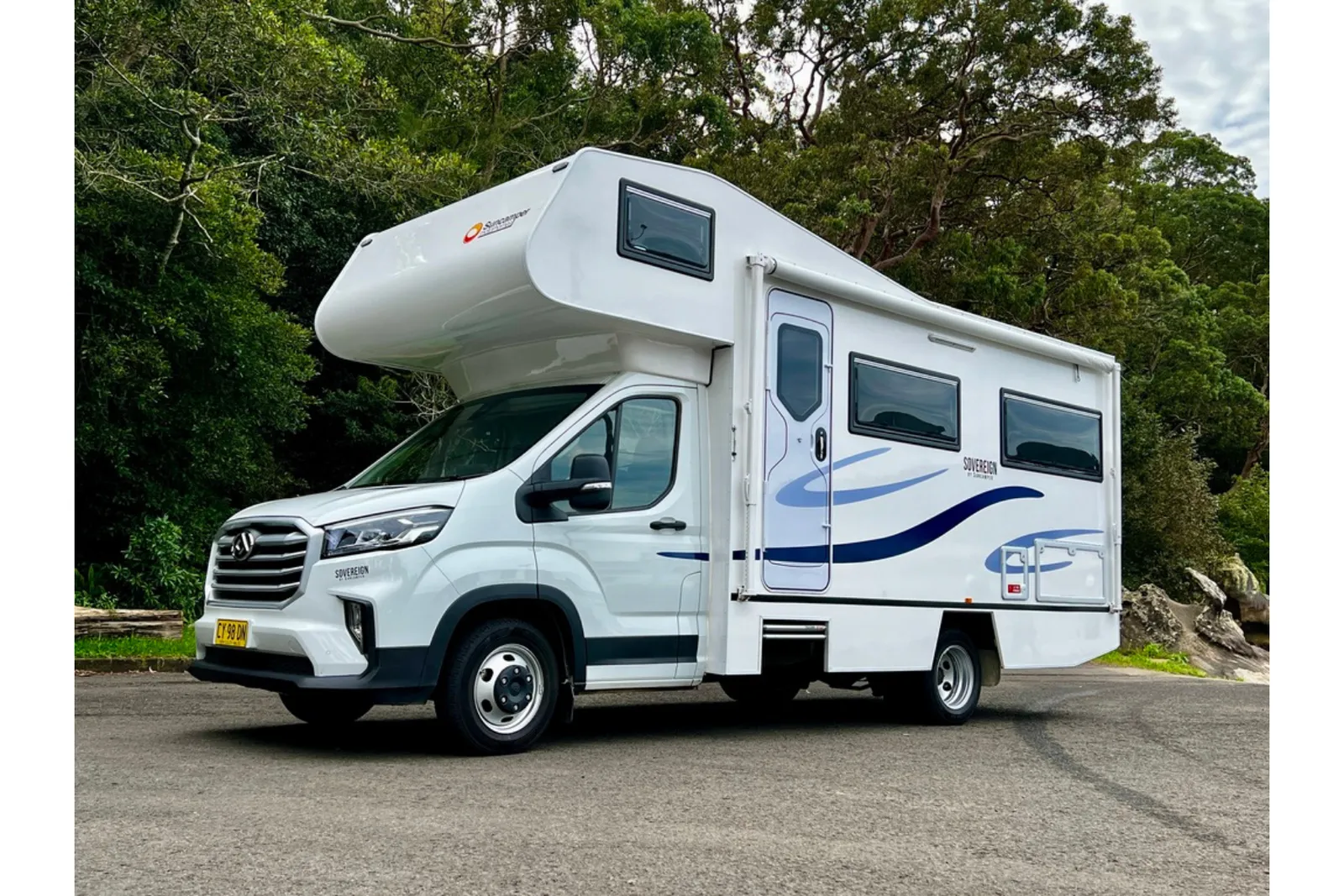It might seem inevitable Chinese-made light commercial vehicles will enter the Australian RV scene and eventually rule, but that isn't necessarily the case. Consider the Japanese: Despite dominating car, SUV and ute sales in Australia they have little presence in the RV industry beyond campervans, some big motorhomes and specialist 4x4 models.
Still, when Chinese manufacturer LDV released its Deliver 9 van and cab-chassis range back in 2020 I wondered when, not if, the first local manufacturer would see an opportunity/be brave enough to bring one to market. At this year’s Sydney show, Belle RV debuted its budget-priced Deliver 9 van-conversion motorhome – the Runaway – while Suncamper displayed its C-class Sovereign Custom on a Deliver 9 cab-chassis. Each manufacturer has taken a different path with its LDV-based product and it's the Suncamper Sovereign Custom that's the subject of this review.
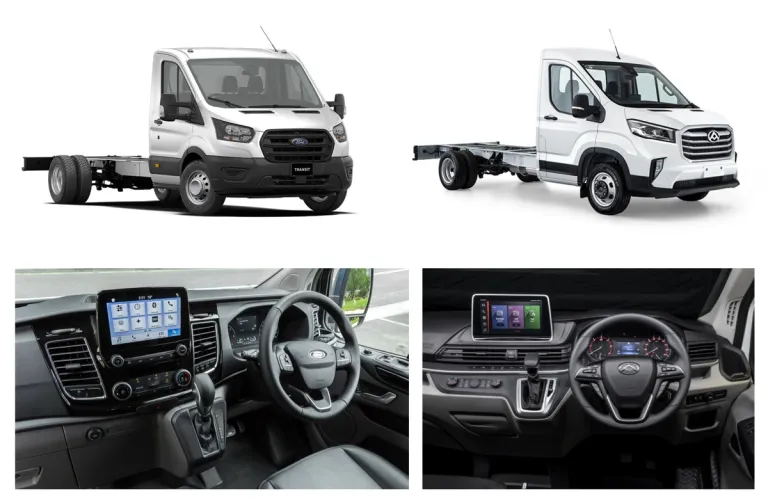
First, however, let's take a close look at the LDV Deliver 9.
Imitation Transit?
They say imitation is the sincerest form of flattery and it appears LDV thinks the Ford Transit is well worth copying. There’s more than a passing similarity between the pair and a cynic would say it goes to prove the Chinese are good at copying but not innovating. You could also argue that when someone else has done all the groundwork, why not improve on it rather than reinvent the wheel? Interestingly from a motorhome point of view, the Transit has been out of favour with local manufactures for years. Initially due to the lack of an auto transmission, I’m not sure what the reason is now, beyond development costs. But I’ve digressed…
Like the Japanese and Koreans before them, Chinese auto manufacturers bought their way into the local market by producing cheap and often cheerless cars and light commercials, whose sole redeeming quality was price. Those models have been quickly followed by better looking, better equipped and safer vehicles backed by extended warranties, but still maintaining a price advantage. Indeed, the rate of development of the Chinese automotive manufacturing industry has been breathtaking and in very short order it has leapfrogged into the 21st century. Today, brands like MG, GWM and Haval are some of the fastest growing and Australians are wholeheartedly embracing Chinese-built vehicles.
In the commercial space, success has been less spectacular, with early GWM (Great Wall Motors) and LDV light commercials earning reputations for poor – okay awful – build quality, reliability, parts supply and resale. Progress has been rapid, however, and now the likes of the Deliver 9 are making significant inroads. In fact it has now passed the Ford Transit in sales in this country. So, how good is the Deliver 9 and, importantly, is it a viable motorhome base vehicle?
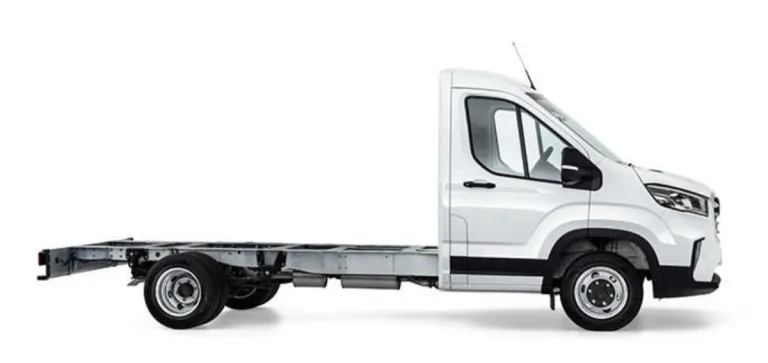
Delivering the Goods?
Let’s cut to the chase: For an RV manufacturer the LDV’s greatest appeal is price and at the time of writing (July 2022), LDV is advertising its one-size-fits-all Deliver 9 cab-chassis for $44,990 drive-away for ABN holders. That’s before any discount for volume sales or promotions to help get the model into a new market. While LDV is open about retail pricing, Ford, Renault, Fiat and others aren’t. Suffice to say, the Deliver 9’s cab-chassis price advantage is likely a minimum $10,000 over its closest Euro rival. That’s a good starting point and it’s backed by a 3 year/160,000 km warranty with roadside assistance. There’s also capped price servicing for 3 years or 95,000 km spread over 4 services. The first is due at just 6 months/5000 km ($287), then it’s 12 months/35,000 km ($400), 24 months/65,000 km ($580) and 36 months/95,000 km ($695).
The Deliver 9 chassis uses a traditional ladder-type frame. The vehicle is 6.20-metres long, has a 3.76-metre wheelbase and a 14.2-metre turning circle. Power is delivered to the dual 16-inch rear wheels with their 195/75R16C Light Truck tyres, and it has a gross vehicle mass (GVM) of 4495 kg. That means it can be driven on a car licence, plus it has a useful 2800 kg braked towing capacity. Suspension is McPherson struts up-front and tapered leaf springs at the rear, while braking is by disc brakes; ventilated on the front wheels and solid on the rears.
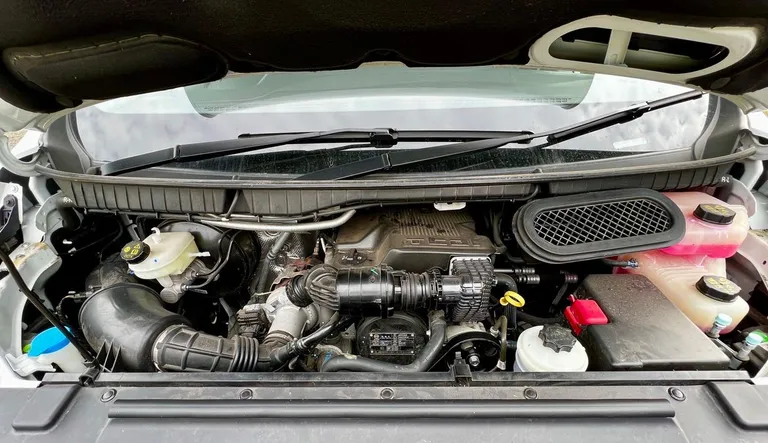
Speaking of power, the engine is a 2.0-litre single-turbo diesel that meets the old Euro 5 standard, meaning no AdBlue fuel additive is required. Output is a relatively modest 110 kW @ 3500 rpm and 375 Nm @ 1500-2400 rpm and its delivered through a conventional 6-speed automatic. Fuel capacity is 80-litres and it comes with a fuel saving stop/start system. Claimed fuel consumption is 7.6 L/100 km and I’d expect 13-15 L/100 km with the motorhome body. However, the trip computer was showing an average of 17.4 L/100 km since new (I’m thinking), which reflects the more ‘spirited’ driving I’d expect for this specific unit. All-in-all the Deliver 9 is mechanically conventional and, would you believe it, almost a dead ringer for the Ford Transit. But what about safety and technology? Read on…
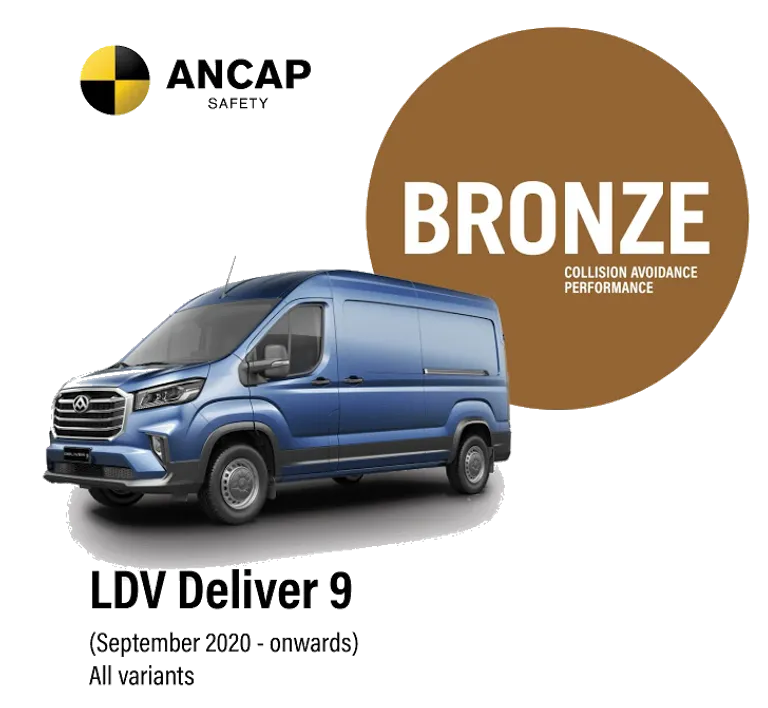
Safety First
Light commercial vehicle safety is a bit of a grey area in Australia, with few vehicles actually crash tested. Even the lauded Mercedes-Benz Sprinter is untested, but in October 2021 the Australasian New Car Assessment Program – ANCAP – released a Commercial Van Safety Comparison that will be the subject of an upcoming story. For now, suffice to say that of the four vans actually crash tested, the Ford Transit Custom (2012), Mercedes-Benz Vito (2014) and the Toyota HiAce (2019) each earned five stars. Scarily, the Mitsubishi Express (2021) earned zero stars – a humiliating first for its Japanese manufacturer…
For LDV, the Deliver 9 brings new firsts in safety and technology, but it’s a mixed bag compared with its rivals and a long way behind the Ford Transit. On the active safety front it features an Antilock Braking System (ABS), Electronic Brakeforce Distribution (EBD), Electronic Stability Control (ESC) , Autonomous Emergency Braking (AEB), Lane Departure Warning (LDW), Brake Assist System (BSA), Hill Hold Assist (HHA) and Adaptive Cruise Control (ACC).
What it lacks in electronic wizardry to equal the best is AEB that also detects pedestrians and cyclists, Lane Keeping Assist (LKA), Blind Spot Monitoring (BSM), a Driver Monitoring System (DMS) to help stop you falling asleep, and a Speed Limiter. In its defence, the Sprinter doesn’t have all these as standard either, while a Renault Master wants for AEB of any kind, LKS, LDW, BMS and DMS in standard trim, but does come with a speed limiter. Woohoo! What of the Transit? It comes with all the systems and earns an ANCAP gold star…
On the passive safety front the Deliver 9 has front, side and curtain airbags, while it also has expected features like remote central locking, electric windows (not one-touch), electric mirrors, cab air-conditioning (not climate control), a multi-function steering wheel (not leather), an 8-way manually adjustable driver’s seat, a 4.2” digital display between the instruments plus a 10.1” touch-screen infotainment system with Apple Car Play (but not Android Auto), a pair of USB charging outlets and more.
As to how the Deliver 9 might fare in a crash, if LDV’s engineers have been as diligent ‘replicating’ the Transit’s structure it should do quite well. Of course that’s speculation as the current Transit cab-chassis also hasn’t been crash tested, but it’s difficult to believe Ford wouldn’t use the same engineering that helped the Transit Custom van earn its five star rating.
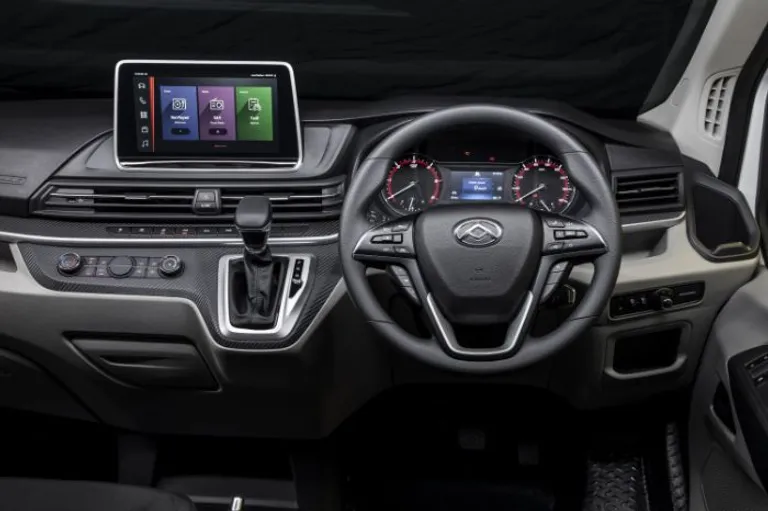
Driving Experience
Nuts and bolts aside, what's the Deliver 9 like behind the wheel? Good – mostly. The cab is modern and well laid out, visibility is good, steering is well weighted and the big infotainment system is easy to use and read, especially in Apple CarPlay mode. The seats are a bit basic, despite the driver’s having a good range of adjustments, and lack a bit of padding plus lumbar support. In the test vehicle, the two-place passenger seat was fixed and not where you’d want to sit for long distances, but there is a single-seat option that should provide more comfort. The lack of one-touch electric window operation was a small but annoying omission, but not as much as the absence of a rest for the left foot, compounded by the slightly odd shape of the driver’s footwell.
Like the Transit, the deliver 9’s little turbo-diesel is on the lower powered side compared with its competitors, while the 6-speed auto lacks a few ratios compared to the latest opposition. The nett effect is this is a vehicle – in a motorhome application at least – requiring a fair bit of ‘wellie’ to get and keep moving, and which runs out of puff on hills sooner than others.
Apart from that the engine and gearbox are smooth and cab noise levels aren’t particularly noticeable, except on concrete roads. Also, the suspension is quite ‘crashy’, lacking European levels of control: It quickly helps you remember this is a delivery truck first and motorhome base-vehicle second. Speaking of refinement, this is where Chinese auto manufacturers’ rush to quickly span development generations becomes apparent.
Having driven a range of current generation Chinese-made vehicles and read quite a few reviews, the single most common issue is the lack of technological refinement in the driving experience. It’s not just an LDV thing, this is common across brands and will, no doubt, be addressed sooner than later. What this translates to on the road is electronic driving aids either too sensitive and intrusive or not sensitive enough.
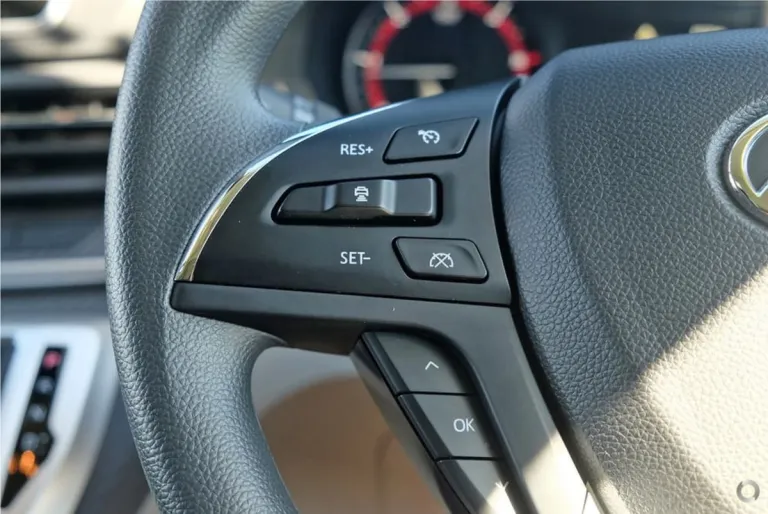
On the test Deliver 9, adaptive cruise control (ACC) was annoying and even dangerous. Good ACC smoothly slows you when there's a vehicle ahead and smoothly accelerates when the road is clear. It's not distracted by terrain or vehicles outside the lane and works almost imperceptibly in the background. And then there’s this one…
Speed changes could be, but weren't always, abrupt, and there appeared no consistency in when it would begin to decelerate when approaching a slower vehicle from behind. Similarly, when the road was clear the engine would surge at what sometimes seemed near-maximum effort to regain the preset speed. Most alarmingly, however, was its tendency to think vehicles in adjoining lanes, roadside obstacles and things like rock faces in a cutting were obstacles and rapidly slow us down. On the freeway this was downright dangerous as you never knew when it would happen and you could easily end up with a B-double up your backside if not careful. In the end it proved best to use ACC only on open and preferably straight roads. A quick online search shows this isn’t an isolated case, so it’s something LDV needs to immediately address. It’s probably a blessing in disguise the Deliver 9 only has Lane Departure Warning rather than Lane Keeping Assist as well, as that might have become an additional, unwelcome battle ground!

Body Matters
Of course the Deliver 9 is only half this story; the other half being the Suncamper C-class motorhome body on its back. The Sovereign Custom is a made-for-rental model that carries and sleeps six, and as such makes perfect sense being attached to the LDV. It’s a spacious if no-frills design as rentals often are; one that parents holidaying with a small tribe or a couple of couples could happily holiday in.
However, it’s built the same way as all Suncamper motorhomes, as this description from the company website explains: “All motorhome models boast a steel frame base and aluminium, fully welded framework for the walls, rear, nose and single-piece roof. Walls and roof are fully insulated with fire-retardant foam and pressed.'
“Framework is extensive so every fitting is screwed into a solid spot, not into insulation. The walls are more than 30mm thick and the roof is more than 45mm. This is more than double (and in some cases triple) other manufacturers. A rust-proofing and sound deadening agent is applied under the floor to protect from noise and road damage”.
It’s also worth noting cabinetry is plywood, not foam-board coated in wood look-a-like and it’s glued-and-screwed like home furniture, not stapled together.
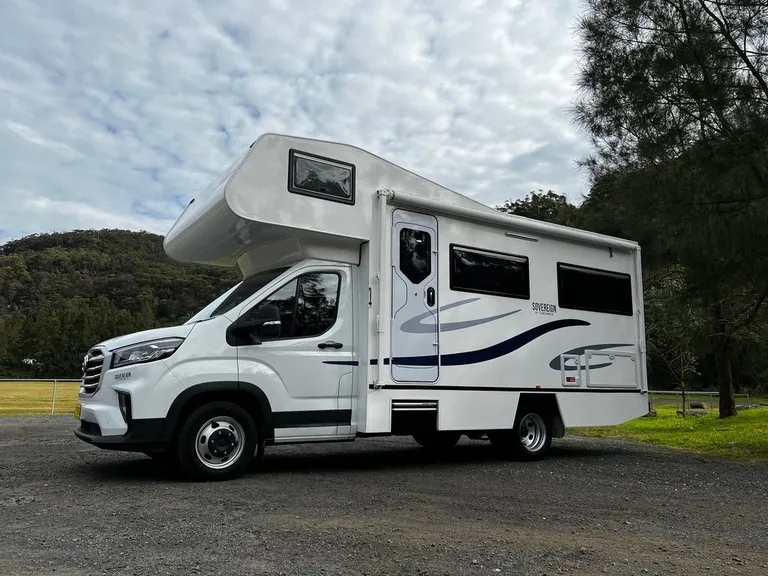
Size Matters
Dimensionally, the Sovereign Custom is 6.95 m long, 2.4 m wide and 3.3 m tall. It has a gross vehicle mass (GVM) of 4490 kg and tare weight of 3300 kg as tested, providing a healthy max payload of 1190 kg for 6 souls and all their necessities, plus water and fuel, LPG and so on. Speaking of water, fresh capacity is 130-litres while grey is 83-litres. Electrically, things are good thanks to a pair of 120 AH deep-cycle house batteries, topped up by a 175 W solar panel. Naturally, LED lighting is used throughout.
Big and boxy to suit its intended purpose, the first things that strikes you is the unusually high floor level, which requires double electric steps and even then, a considerable step-up to the first one. At 165 cm, Mrs found it quite a chore, compounded by the lack of an external grab handle that was yet to be fitted. I found this puzzling and also noted the sizeably deep fairing between top of the cab and the bodywork above. It tuns out that because the Deliver 9’s cab roofline curves upwards quite a bit at the rear, the body had to be mounted higher on the chassis to accomodate the over-cab bed. Thus, the floor is higher than usual, necessitating the extra steps. Bugger…
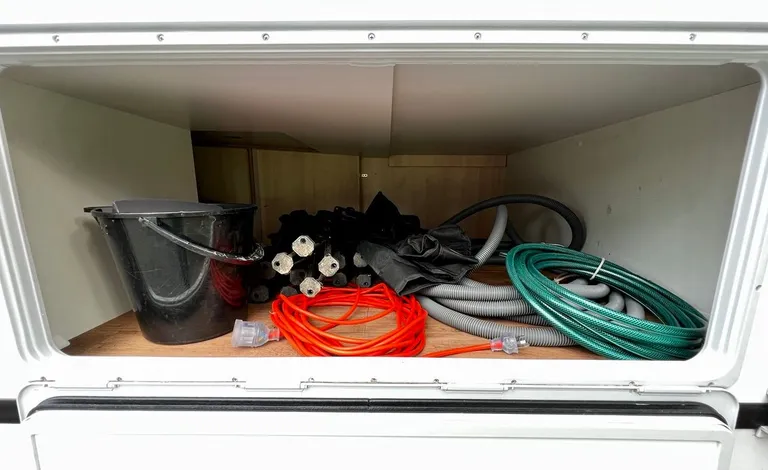
External storage is limited to single locker on the kerb-side rear, which accesses space under the corner bed. It has room for a table and chairs, hoses, etc, but as a rental not a lot of travel bags would also fit. There’s a locker close by for the pair of 4 kg LPG cylinders, plus an access hatch for the toilet cassette on the driver’s side. Apart from that the body sides are smooth and easy to clean, while a large roll-out awning and double-glazed acrylic windows are fitted. There’s plenty of room on the back wall for a bike rack too, something rental customers would no-doubt appreciate.
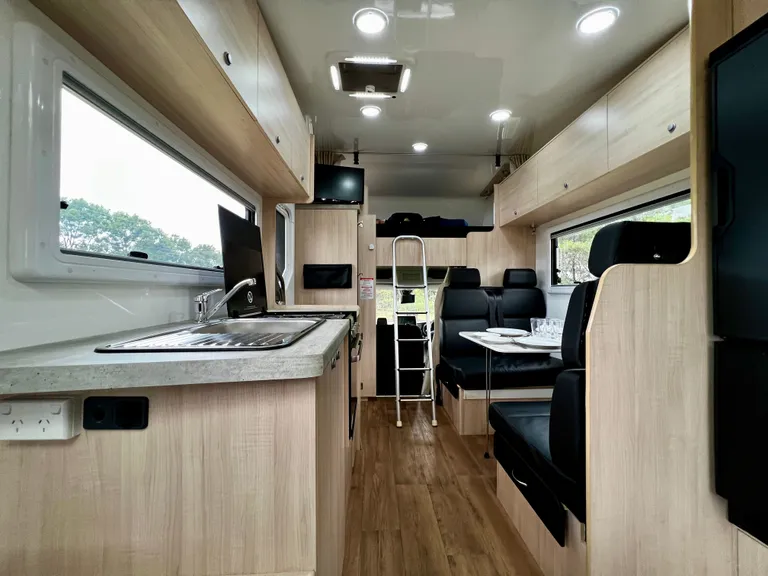
Inside Story
Climbing inside reveals a ton of headroom and a spacious floorplan, especially considering there’s no slide-out. It has an over-cab bed (that’s why it’s called a C-class), central kitchen and four-seat cafe-style dinette, and a kerb-side corner bed, with the bathroom in the driver’s-side rear corner.
Glossy white walls, light-timber cabinetry and darker wood-effect flooring deliver a bright if somewhat minimalist feel, as do the flat-fronted cabinets. However, the black upholstery and mattress covers seem a bit severe and could be lightened-up to help customers into holiday mode. There’s plenty of natural light too, aided in no small part by the large hatch above the corner bed. The over-cab bed, accessed via the usual aluminium ladder, seems to be the larger of the two permanent beds; the rear corner bed – also known as a French Bed – suffers from the chamfered corner usual with this design. The dinette converts to a child-friendly double, with bed boards and the ladder stored in a slim cupboard just to the left of the door as you enter.
The over-cab bed doesn’t lift, which is no issue as the current seating arrangement precludes walk-through cab access, but future models will have a single passenger seat and a tilt-up bed would be handy in that situation.
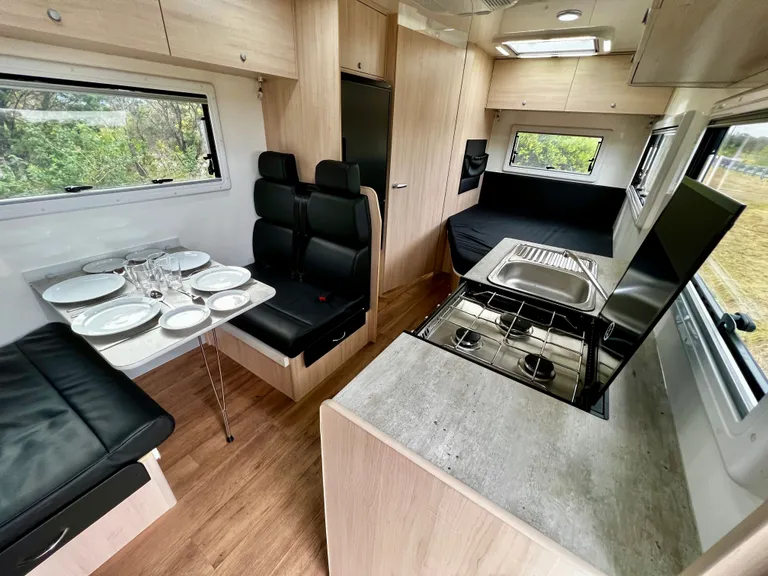
Four diners are well catered for, but two extras will likely be sitting on the corner bed, given the lack of swivelling cab seats or cab access. Those lucky enough to score a proper dining position will appreciate the decent table size, view from the large window and comfort from the well padded, belt-equipped seats.
The family chef will appreciate the good bench space, triple burner gas cooktop with grill and oven, sink with drainer and the excellent 150-litre 2-door fridge/freezer that runs solely on 12-volt power. There’s also a microwave above the fridge, but of course it requires mains power. Whilst there’s no range-hood there is a large window that runs almost full length behind the kitchen unit. Cupboard space is good, but some has no shelving, or just one in a big cupboard, and a bit of extra thought could make this valuable space more efficient.
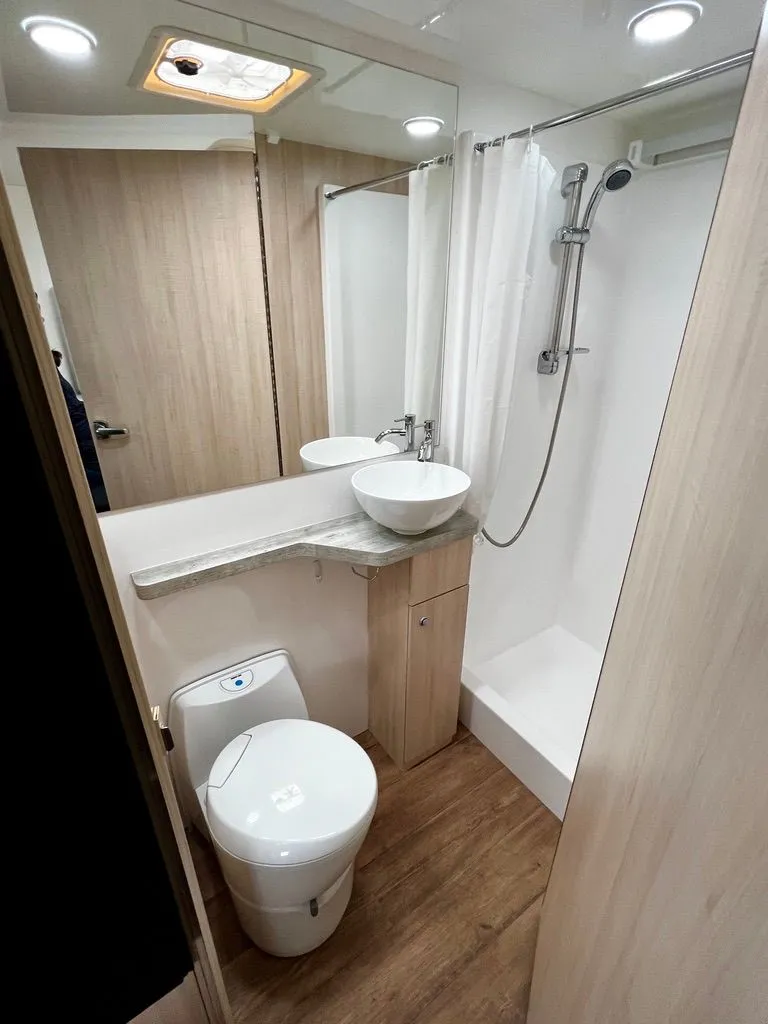
Come wash time, people will appreciate the well proportioned bathroom with its separate shower and sufficient space to dry-off and dress (or just change) – a feature not found in every motorhome bathroom. There’s a swivel-head cassette toilet, handbasin with the cupboard storage below, a height-adjustable shower, bright lighting, a roof fan-hatch and lots of mirrors. The only downside is a shower curtain rather than a screen or door, as there’s nothing worse than being chased by a cold, clingy curtain whilst washing!
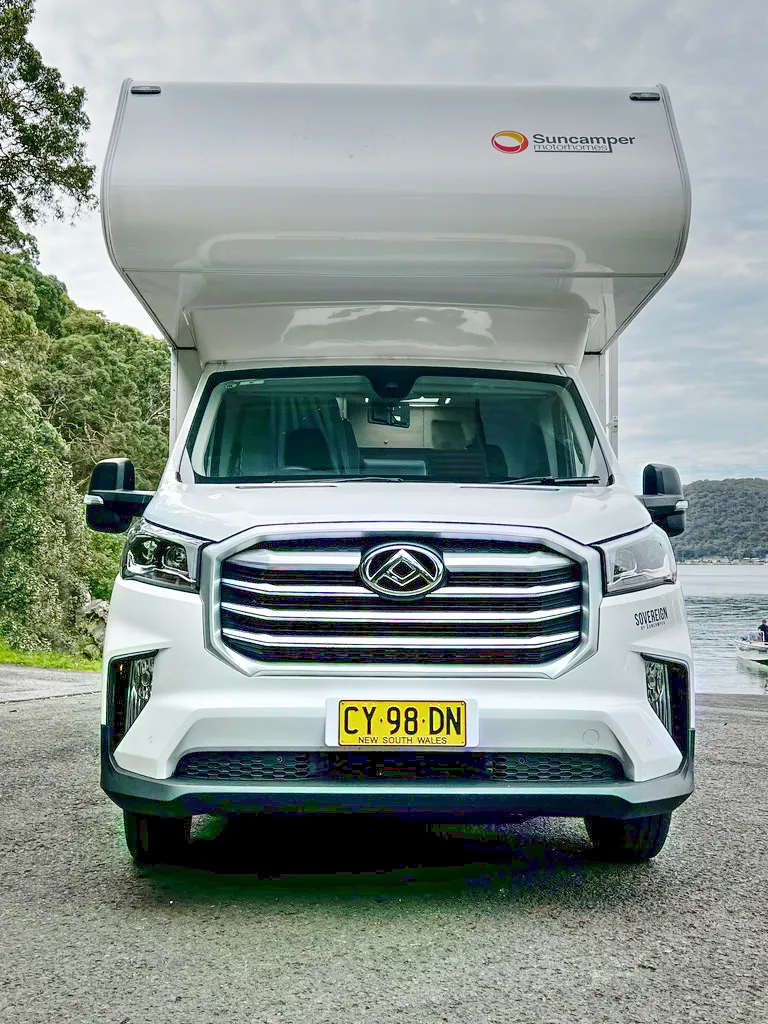
Food for Thought
My main interest in reviewing the Suncamper Sovereign Custom was to spend time in the new LDV Deliver 9. Summing up, it looks good, is modern, seems well built, has good equipment levels and is a ‘nice’ drive. Surface ‘wow’ disguises some ‘oh’ issues, but an owner would soon come to terms with its few foibles and feel at home. It’s also backed by a decent warranty and a capped-price service plan, although again, neither is class leading. For the price, however, it appears a good buy and only time will tell in terms of reliability, service support and parts supply.
Suncamper’s Sovereign Custom is a purpose-built rental model that will also appeal to larger families or people looking to mix-and-match private ownership with income production via a company like Camplify. Suncamper has a solid reputation for sturdy construction and longterm durability, and the generational change taking place within the company is a positive sign for continued service and support, not to mention product development.
Given the LDV Deliver 9’s relative bargain status the Sovereign Custom’s $169,000 base price surprises, but then what are the 6-berth alternatives? Apollo/Winnebago have a couple of models in the low $190,000s and while Jayco doesn’t list a 6-berth motorhome on its website, its rental arm – Let’sgo – does. Go figure. Avida seems to have quietly dropped the Ceduna as it’s no longer on its website, so the Sovereign Custom doesn’t appear to have too much competition.
So, what’s my Chinese ‘take-away’ from all this? The LDV Deliver 9 has genuine promise as a budget motorhome base vehicle, but needs some tweaking and will benefit from further development. Chinese auto makers are quick to update even current models in response to feedback and so it can only get better.
Suncamper’s Sovereign Custom targets a niche market and so is unlikely to find many buyers amongst Mum & Dad motorhomers. Given the rushed prototype status of this particular vehicle it has held-up well to more than 19,000 km of staff and rental customer operation, and only needs a few tweaks to be top of its game. Will other motorhome manufacturers follow Suncamper’s lead? Again, only time will tell.

